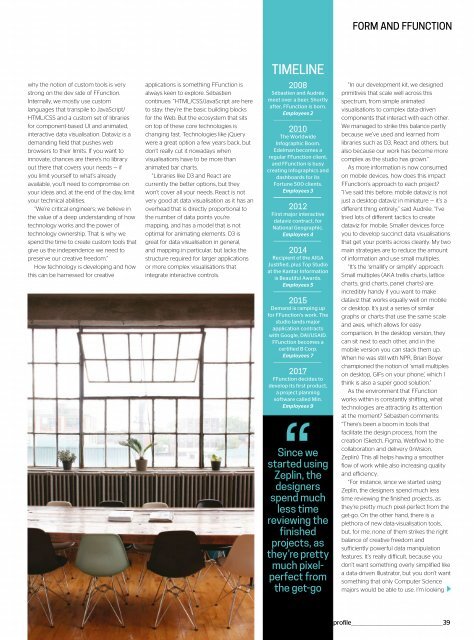Web_Designer_UK__May_2018
You also want an ePaper? Increase the reach of your titles
YUMPU automatically turns print PDFs into web optimized ePapers that Google loves.
FORM AND FFUNCTION<br />
TIMELINE<br />
whythenotionofcustomtoolsisvery<br />
strong on the dev side of FFunction.<br />
Internally,wemostlyusecustom<br />
languagesthattranspiletoJavaScript/<br />
HTML/CSS and a custom set of libraries<br />
for component-based UI and animated,<br />
interactivedatavisualisation.Datavizisa<br />
demanding field that pushes web<br />
browsers to their limits. If you want to<br />
innovate, chances are there’s no library<br />
out there that covers your needs — if<br />
you limit yourself to what’s already<br />
available, you’ll need to compromise on<br />
your ideas and, at the end of the day, limit<br />
your technical abilities.<br />
“We’re critical engineers; we believe in<br />
the value of a deep understanding of how<br />
technology works and the power of<br />
technology ownership. That is why we<br />
spend the time to create custom tools that<br />
give us the independence we need to<br />
preserve our creative freedom.”<br />
How technology is developing and how<br />
this can be harnessed for creative<br />
applications is something FFunction is<br />
always keen to explore. Sébastien<br />
continues: “HTML/CSS/JavaScript are here<br />
to stay: they’re the basic building blocks<br />
for the <strong>Web</strong>. But the ecosystem that sits<br />
on top of these core technologies is<br />
changing fast. Technologies like jQuery<br />
wereagreatoptionafewyearsback,but<br />
don’treallycutitnowadayswhen<br />
visualisations have to be more than<br />
animated bar charts.<br />
“Libraries like D3 and React are<br />
currently the better options, but they<br />
won’tcoverallyourneeds.Reactisnot<br />
very good at data visualisation as it has an<br />
overhead that is directly proportional to<br />
thenumberofdatapointsyou’re<br />
mapping, and has a model that is not<br />
optimal for animating elements. D3 is<br />
great for data visualisation in general,<br />
and mapping in particular, but lacks the<br />
structure required for larger applications<br />
or more complex visualisations that<br />
integrate interactive controls.<br />
2008<br />
Sébastien and Audrée<br />
meetoverabeer.Shortly<br />
after,FFunctionisborn.<br />
Employees 2<br />
2010<br />
The Worldwide<br />
Infographic Boom.<br />
Edelman becomes a<br />
regular FFunction client,<br />
and FFunction is busy<br />
creating infographics and<br />
dashboards for its<br />
Fortune 500 clients.<br />
Employees 3<br />
2012<br />
First major interactive<br />
dataviz contract, for<br />
National Geographic.<br />
Employees 4<br />
2014<br />
Recipient of the AIGA<br />
Justified, plus Top Studio<br />
at the Kantar Information<br />
is Beautiful Awards.<br />
Employees 5<br />
2015<br />
Demand is ramping up<br />
for FFunction’s work. The<br />
studio lands major<br />
application contracts<br />
with Google, DAI/USAID.<br />
FFunction becomes a<br />
certifiedBCorp.<br />
Employees 7<br />
2017<br />
FFunction decides to<br />
develop its first product,<br />
a project planning<br />
software called Min.<br />
Employees 9<br />
Since we<br />
started using<br />
Zeplin, the<br />
designers<br />
spend much<br />
less time<br />
reviewing the<br />
finished<br />
projects, as<br />
they’re pretty<br />
much pixelperfect<br />
from<br />
the get-go<br />
“In our development kit, we designed<br />
primitives that scale well across this<br />
spectrum,fromsimpleanimated<br />
visualisations to complex data-driven<br />
components that interact with each other.<br />
Wemanagedtostrikethisbalance partly<br />
because we’ve used and learned from<br />
libraries such as D3, React and others, but<br />
also because our work has become more<br />
complexasthestudiohasgrown.”<br />
Asmoreinformationisnow consumed<br />
on mobile devices, how does this impact<br />
FFunction’s approach to each project?<br />
“I’ve said this before: mobile dataviz is not<br />
justadesktopdatavizinminiature — it’s a<br />
different thing entirely,” said Audrée. “I’ve<br />
triedlotsofdifferenttacticsto create<br />
dataviz for mobile. Smaller devices force<br />
you to develop succinct data visualisations<br />
that get your points across cleanly. My two<br />
main strategies are to reduce the amount<br />
of information and use small multiples.<br />
“It’sthe‘smallifyorsimplify’ approach.<br />
Small multiples (AKA trellis charts, lattice<br />
charts, grid charts, panel charts) are<br />
incredibly handy if you want to make<br />
dataviz that works equally well on mobile<br />
or desktop. It’s just a series of similar<br />
graphs or charts that use the same scale<br />
andaxes,whichallowsforeasy<br />
comparison. In the desktop version, they<br />
can sit next to each other, and in the<br />
mobile version you can stack them up.<br />
When he was still with NPR, Brian Boyer<br />
championed the notion of ‘small multiples<br />
on desktop, GIFs on your phone’, which I<br />
thinkisalsoasupergoodsolution.”<br />
As the environment that FFunction<br />
workswithinisconstantlyshifting, what<br />
technologies are attracting its attention<br />
at the moment? Sébastien comments:<br />
“There’s been a boom in tools that<br />
facilitate the design process, from the<br />
creation (Sketch, Figma, <strong>Web</strong>flow) to the<br />
collaboration and delivery (InVision,<br />
Zeplin). This all helps having a smoother<br />
flow of work while also increasing quality<br />
and efficiency.<br />
“For instance, since we started using<br />
Zeplin, the designers spend much less<br />
time reviewing the finished projects, as<br />
they’re pretty much pixel-perfect from the<br />
get-go. On the other hand, there is a<br />
plethora of new data-visualisation tools,<br />
but, for me, none of them strikes the right<br />
balance of creative freedom and<br />
sufficiently powerful data manipulation<br />
features. It’s really difficult, because you<br />
don’t want something overly simplified like<br />
a data-driven Illustrator, but you don’t want<br />
something that only Computer Science<br />
majors would be able to use. I’m looking<br />
profile___________________________________________________39



